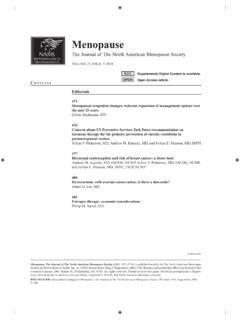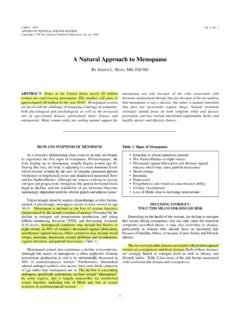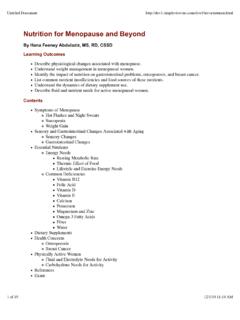Transcription of MENOPAUSE: UNDERSTANDING AND MANAGING THE …
1 menopause : UNDERSTANDING AND MANAGING THE TRANSITION USING ESSENTIAL OILS VS. TRADITIONAL ALLOPATHIC MEDICINE by Melissa A. Clanton A thesis submitted in partial fulfillment of the requirements for the Diploma of Aromatherapy 401 Australasian College of Health Sciences Instructors: Dorene Petersen, Erica Petersen, E. Joy Bowles, Marcangelo Puccio, Janet Bennion, Judika Illes, and Julie Gatti ii TABLE OF CONTENTS List of Tables and iv v 1 Chapter 1 Female Reproduction 1a The Female Reproductive 4 1b - The Female 9 1c The Menstrual Cycle and 12 Chapter 2 Physiology of menopause 2a What is menopause ? .. 16 2b - Physiological Changes of menopause .. 20 2c Symptoms of menopause .. 23 Chapter 3 Allopathic Approaches To Menopausal Symptoms 3a Diagnosis and Common Medical Treatments.
2 27 3b Side Effects and Risks of Hormone Replacement Therapy .. 32 3c Retail Cost of Common Hormone Replacement 36 Chapter 4 Aromatherapy 4a What is Aromatherapy?.. 38 4b Essential Oil History and 42 4c Physiology of Aromatherapy in the 48 iii 4d Essential Oil 58 4e Pharmacological Risks of Essential Oils .. 66 Chapter 5 Aromatherapy and menopause 5a Essential Oils Useful for Menopausal Symptoms .. 74 5b Recommended Blends for Menopausal 78 5c Cost of Essential Oil Blends .. 84 Chapter 6 Conclusions: Allopathic or Aromatherapy?.. 87 90 Bibliography .. 99 Endnotes ..116 iv LIST OF TABLES AND FIGURES Figure The Female Reproductive Table Statistics - Number of United States Figure The Limbic and Olfactory Figure The Figure Essential Oil Table Functional Effects of Essential Oil Table Other Known Essential Oil v ACKNOWLEDGMENTS The author wishes to acknowledge the faculty, staff, and members of the Australasian College of Health Sciences; the members of the Australasian College Discussion list; Doreen Palmer - my mother, mentor, and inspiration for this discussion; Billie Marian my godmother and contributor to editing; and my family for their guidance, input and support.
3 Thank you all so much for your help. The author hopes that this discussion proves to be beneficial, informative, and educational for any woman going through menopause , and gives them knowledge as to the benefits of balancing the body during this transition using aromatherapy and essential oils. 1 Introduction Every morning I greeted myself in the early winter light with the same ritual. Looking in the mirror with utmost seriousness I would pull the loose skin of my jowls behind my ears and contemplate the physical, emotional, and financial ramifications of a face lift. I dealt with the loose skin of the lower regions of my anatomy by refusing to look in the mirror altogether. For two months, I was sure that I was having hot flashes until I finally realized that they occurred only while I was standing under the bathroom lights for the protracted morning scrutiny.
4 Even this was not reassuring for all I knew that menopause was surely on it s way. i Joan Boryensko A Woman s Book of Life menopause has been given many names by many different cultures. The change. The climacteric. The crowning. In American culture, menopausal women are often viewed as old, sexless women who complain of hot flashes and weight gain. This American view of menopause is not common in most other cultures and societies. The Cherokee Indians believed that women did not enter adulthood until the age of 51. In Celtic cultures, the elder woman was seen as the seed 2 the part that contains all the knowledge of the parts within it. The elder s role was to go forth and reseed the community with her wisdom. Anthropologists Margaret Mead and Judith K. Bwon studied the status of women in primitive cultures around the world.
5 They found that women who have reached menopause are crowned wise women, midwives, healers, and givers of In a wide diversity of ancient cultures from North American to Middle Eastern, African to Aborigine, and European to Icelanders, postmenopausal women are valued for their intuitive wisdom. In ancient times, these women were trained as oracles, priestesses, shamans, and menopause is an empowering spiritual and physiological change. Comprehending the reasons why menopause occurs, and the symptoms it creates, gives a greater UNDERSTANDING into this changing time of the female body. Unfortunately, for many women, some uncomfortable and unpleasant symptoms accompany this transition. Although the symptoms of menopause are normal physiological occurrences during this time, it has become commonplace in the medical field to administer medication to stop the symptoms.
6 A large number of women find it necessary to manage these symptoms through medication. Physicians 3 routinely prescribe hormone replacement therapy for women experiencing premenopausal and menopausal symptoms. The risks and side effects of these hormone replacement drugs can be serious and even deadly. Increasingly, statistics and studies show that hormone replacement therapy is not an effective or healthy way to manage menopausal symptoms. Fortunately, there are safe alternative methods of effectively treating menopausal symptoms. One of these methods is aromatherapy. Aromatherapy and the use of essential oils for healing benefits date back to Egyptian times. It is a natural and much less dangerous way of balancing the body and MANAGING menopausal symptoms. Aromatherapy can positively impact the immune system by improving mood, increasing brain activity, and enhancing other biological functions important to health and Easing the transition through menopause using aromatherapy is a relaxing and safe way to manage the physiological changes of menopause .
7 4 Chapter 1 Female Reproduction The Female Reproductive System In order to understand menopause , we must first understand the parts of the female body that make up the reproductive system, as well as the hormones that control the actions of the reproductive system. The female body is amazing in that it has the ability to bring forth life into the world, and we must understand the physiological processes that allow this to occur. The female reproductive system consists of many parts, all of which play a vital role in reproduction. The organs of the female reproductive system include the ovaries, uterus, vagina, vulva, fallopian tubes, breasts, and Bartholin s glands. The ovaries are the essential organs of reproduction. The female sex cells, or ova, are produced here. The ovaries also secrete the female sex hormones, estrogen and progesterone. The two ovaries resemble large almonds and attach on either side of the uterus by ligaments in the pelvic cavity.
8 5 The Female Reproductive System Figure 6 The fallopian tubes, or oviducts, act as ducts for the ovaries, connecting them to the uterus. The outer edge of each fallopian tube ends in a funnel-shaped structure with finger-like projections called fimbriae. The outer edges of the tubes curve over the ovary and into the abdominal cavity. The inner ends of the fallopian tubes attach to and open into the uterus. The uterus has three functions: menstruation, pregnancy, and labor. It is a small pear shaped organ made up mostly of muscle with a small inner cavity. It lies in the pelvic cavity behind the bladder. The upper portion of the uterus is called the body, and the lower portion of the uterus is called the cervix. The uterus rounds out to form the fundus just above where the fallopian tubes attach. The vagina opens to the exterior, and ends at the cervix. The sperm enter the female body through the vagina, and it is also where a baby emerges.
9 The vagina is a tube about 4 inches long made up of smooth muscle and mucous membranes. It is located between the bladder and the rectum in the pelvic cavity. The vulva is the external genitalia of the female. It consists of the mons pubis, clitoris, labia minora, labia majoris, and the hymen. The mons pubis is a skin 7 covered pad of fat over the symphysis pubis bone. The labia majora are elongated folds, or lips, made up of fat and glands. The labia minora are also folds of modified skin and are located within the labia majora. The clitoris is located behind the anterior junction of the labia minora. It is the erectile tissue in the female. The hymen is the membrane that partially closes the vaginal orifice. The vestibule is located in the area between the labia minora and the vaginal opening. It contains several structures of the female reproductive system. The Bartholin s glands are two ducts that open into both sides of the vestibule.
10 The function of the Bartholin s glands is secretion of a lubricating fluid. The two breasts are located over the pectoral muscles. Their function is to produce milk for a baby after its birth. Each breast has lobes that consist of several lobules. Each lobule contains milk-secreting cells called alveoli. The alveoli drain through lactiferous ducts, which converge at the nipple. The colored area around the nipple is the areola. All of these organs of the female reproductive system play a vital role in the physiological processes of the body. Although the organs are vital for reproduction, they cannot function alone. The brain and the endocrine system, 8 which regulate and control the body s hormones, work alongside the reproductive system to allow it to function properly. 9 The Female Hormones The functions of the female reproductive system are regulated by hormones produced in the brain and endocrine glands.









